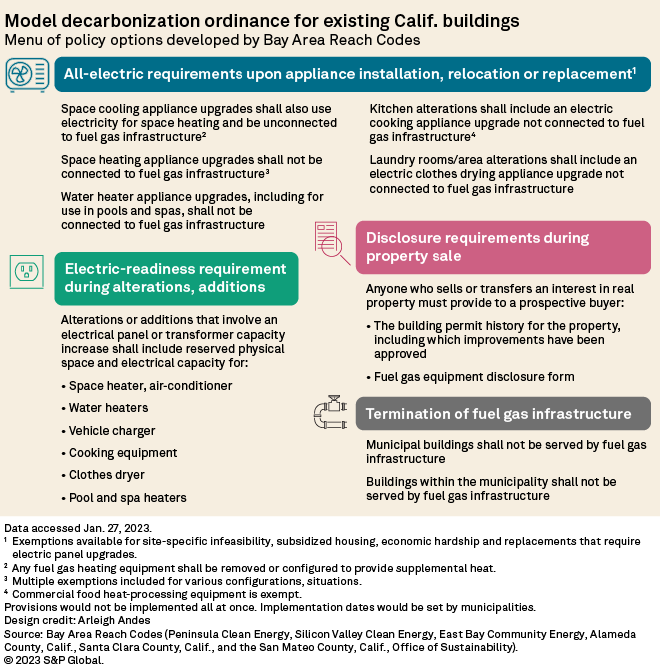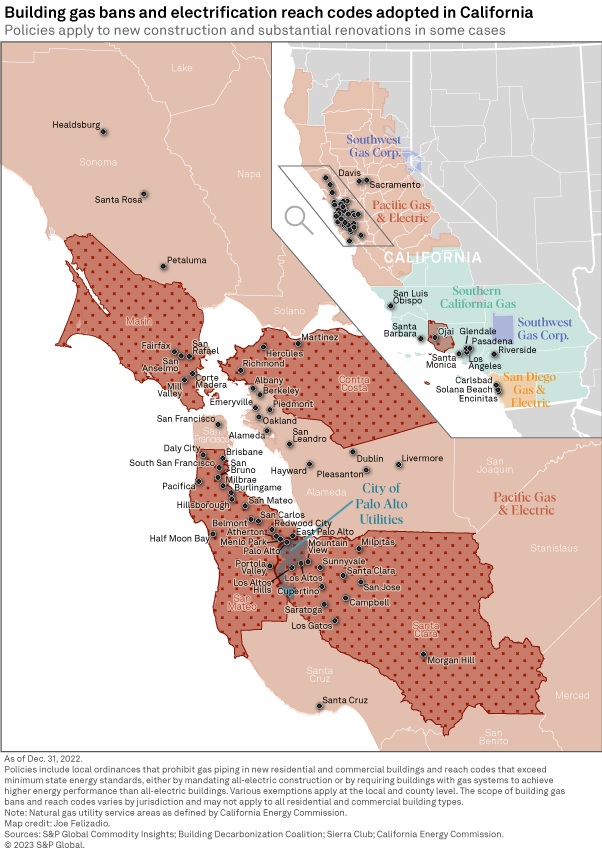S&P Global Offerings
Featured Topics
Featured Products
Events
S&P Global Offerings
Featured Topics
Featured Products
Events
S&P Global Offerings
Featured Topics
Featured Products
Events
Banking & Capital Markets
Economy & Finance
Energy Transition & Sustainability
Technology & Innovation
Podcasts & Newsletters
Banking & Capital Markets
Economy & Finance
Energy Transition & Sustainability
Technology & Innovation
Podcasts & Newsletters
S&P Global Offerings
Featured Topics
Featured Products
Events
2 Feb, 2023

|
San Mateo, Calif., is one of the first cities to begin implementing new policies to decarbonize existing buildings. The policies were developed by Bay Area Reach Codes, a regional coalition seeking to electrify San Francisco Bay Area buildings. |
After three years of steadily restricting natural gas use in new construction, San Francisco Bay Area communities have turned to a bigger goal: requiring existing buildings to go all-electric.
A handful of towns and cities in the region have begun requiring homeowners to install electric appliances and prepare their homes for future electrification when they replace gas equipment or undertake renovations. Some communities have also set a target date for discontinuing gas service within their borders, a policy known as "end of flow."
Like the earlier all-electric campaign for new construction, the effort to electrify existing buildings is a partnership among cities, counties and community choice aggregators, or CCAs, which are government-run entities that procure clean power for their service territories. Yet electrification advocates widely acknowledge that retrofitting buildings in California — one of the nation's top gas consumers — will be a longer and more costly endeavor.
"Obviously, it's going to be a more challenging process, and we have to do it very sensitively," said Rafael Reyes, director of energy programs at Peninsula Clean Energy, a CCA serving San Mateo County, in an interview. "We are very concerned about scenarios where it can be very expensive and challenging for homeowners to make these kinds of changes."

Beginning in 2019, Peninsula Clean Energy worked with Santa Clara County's CCA, Silicon Valley Clean Energy, to develop all-electric reach codes for new buildings. They rebranded their partnership as Bay Area Reach Codes after teaming with Alameda County's CCA, East Bay Community Energy, in 2021. The coalition released a model decarbonization ordinance for existing buildings in June 2022.
The model ordinance is a menu of policy options. Bay Area Reach Codes does not expect communities to adopt them all at once. Instead, the organization anticipated that local lawmakers would gradually implement the policies as more support becomes available, Reyes said.
Cities start with small steps
This gradual approach has been used by two early adopters in the Bay Area, the city of San Mateo and the town of Portola Valley, according to Reyes. "They've adopted codes that relate to things that are actually very easy to do today," Reyes said.
In fall 2022, both communities adopted a policy that required homeowners to buy an electric heat pump — which provides both space heating and cooling — rather than installing or replacing an air-conditioner. The policy makes gas furnaces redundant or relegates them to backup heating.
The communities also adopted electric-ready provisions that Piedmont, Calif., pioneered in 2021. San Mateo required homeowners to install outlets for electric appliances during kitchen and laundry room renovations, and both communities required enough capacity for future electrification as part of electric panel upgrades and replacement projects.
San Mateo adopted one other policy from the model ordinance: requiring homeowners to install an electric heat pump water heater when they replace a water heater during a planned home alteration.
The policies "are really structured to intervene at a time that's most convenient and cost-effective for property owners," San Mateo sustainability analyst Andrea Chow told S&P Global Commodity Insights. "That property owner is already planning a project or planning to replace equipment."
Cost and grid capacity in focus
Climate advocates urged the San Mateo City Council to also require homeowners to install heat pumps for space heating during home alterations.
However, city staff determined that the cost difference between replacing a new gas furnace — typically about $4,000 to $6,000 — and installing a heat pump — about $18,000 to $21,000 — was too high, Chow said during an October 2022 city council meeting. Lawmakers used air-conditioning installation as the trigger for the heat pump requirement because rebates can make a heat pump project cost-effective compared to installing an air conditioner.

In November 2022, lawmakers in Palo Alto, Calif., made the same decision. They required heat pumps for water heating but not space heating during residential alteration projects.
In a report, city staff cited cost and "significantly higher" electric demand for space heating versus water heating. Staff proposed revisiting an electric space heating mandate after the City of Palo Alto Utilities ramps up its effort to modernize its electric grid. The municipal utility maintains the city's electric distribution infrastructure, while Pacific Gas and Electric Co. provides that service across most of the Bay Area.
"We have an obligation to also look at how we're going to maintain the grid, so we're trying to work out some of those particulars before we get into a mandate for mechanical equipment replacements," George Hoyt, chief building official for Palo Alto, told Commodity Insights. "Our utility department is underway with that effort, and that is really key to our future sustainability approaches."
Burnout provisions and end of flow
Permitting data underscored the incremental approach that policymakers have taken thus far. Over the past five years, San Mateo — a city of more than 100,000 people — issued an average of 58 permits per year for new or replaced air-conditioning units, according to a presentation by Chow in September 2022. The water heater replacement ordinance would impact about 130 projects per year, Chow estimated.
Yet San Mateo is evaluating more ambitious policies from the model ordinance. Among them, one would require homeowners to install electric space and water heating appliances when gas equipment reaches the end of its useful life, a policy sometimes called a "burnout" provision. Climate advocates proposed prohibiting gas appliance replacements by 2025. City staff is preparing to study that idea and other decarbonization strategies.
In nearby Half Moon Bay, lawmakers considered but ultimately did not include a burnout provision in their initial package of electrification mandates in 2021. But the city introduced a concept that Bay Area Reach Codes incorporated into its model ordinance: It set a 2045 deadline to cap or decommission all gas lines.
San Mateo will also explore implementing this end-of-flow policy by 2030, another proposal put forward by climate activists. This deadline could conflict with a burnout provision. The concept behind the latter is to reduce the burden of phasing out gas equipment by allowing residents to convert to electric appliances at the end of a gas heating unit's typical 15-20 year lifespan.
Chow said the burnout provision and end-of-flow policy are just two policies that her staff will evaluate in pursuit of San Mateo's blue-sky ambition to decarbonize existing buildings by 2030. These policies have yet to go through careful impacts and benefits analysis or stakeholder engagement, Chow said.
"That's what we want this process to entail — what are realistic time frames?" Chow said. "Because I think we have some very promising and supportive information in movement on the regional and state level. And so all of that is going to build momentum in the city of San Mateo towards these decarb goals."
Program support seen as critical
To that point, the California Public Utilities Commission is exploring ways to decommission gas distribution systems, while the California Air Resources Board is considering implementing a zero-emissions standard for newly installed space and water heaters by 2030. The Bay Area Air Quality Management District is considering similar measures to ban gas equipment as soon as 2027, which would help to lower emissions of nitrogen oxides, or NOx, a group of health-harming gases formed by burning fuel at high temperatures.
Bay Area Reach Codes is now chiefly focused on developing support programs to reduce the burden of transitioning from gas, Reyes said.
These programs would include rebates and low-cost financing. In October 2022, Peninsula Clean Energy began offering $10,000 in interest-free financing for electric heat pump installations, as well as rebates ranging from $1,000 to $3,500 for appliance purchases and panel upgrades. These rebates would stack with other regional rebates and incentives in the federal Inflation Reduction Act, Reyes said.
But program support would also mean making sure that equipment, trained contractors and information channels are available, Reyes said. There should also be a turnkey option for customers who want to electrify but do not want to choose their own products and contractors, Reyes said. A loan program for temporary gas water heaters would also ensure customers have access to hot water in cases where a heat pump installation requires additional electrical work, Reyes added.
S&P Global Commodity Insights produces content for distribution on S&P Capital IQ Pro.
